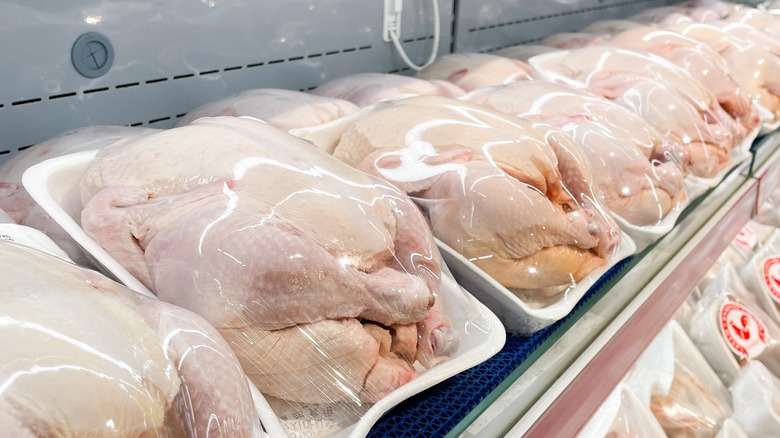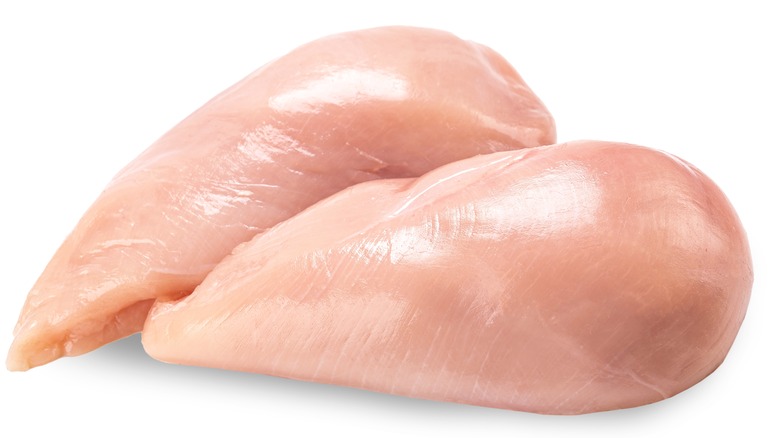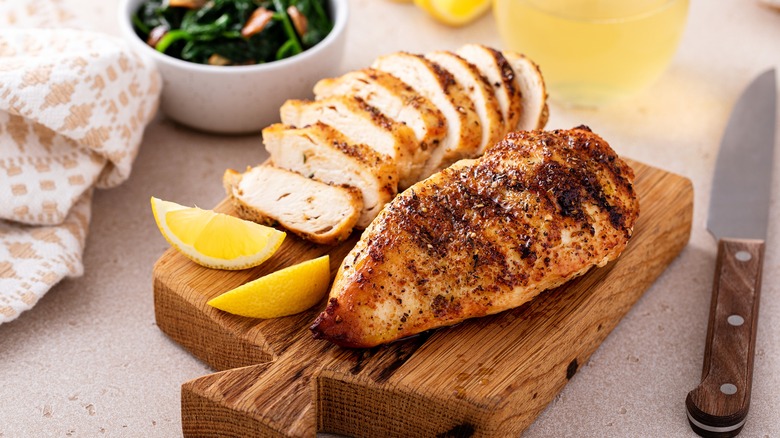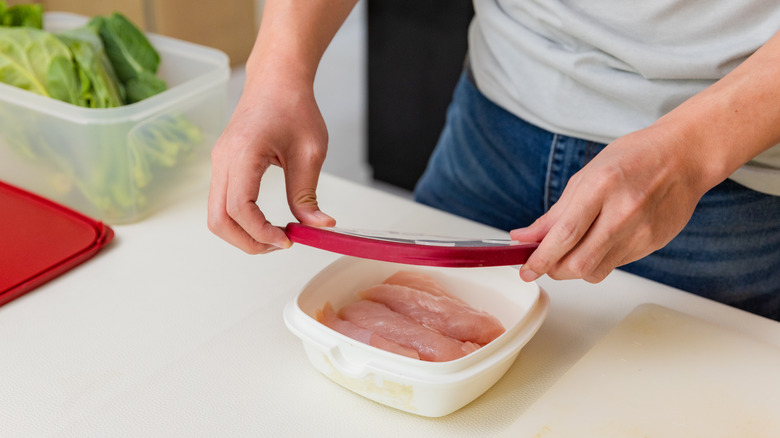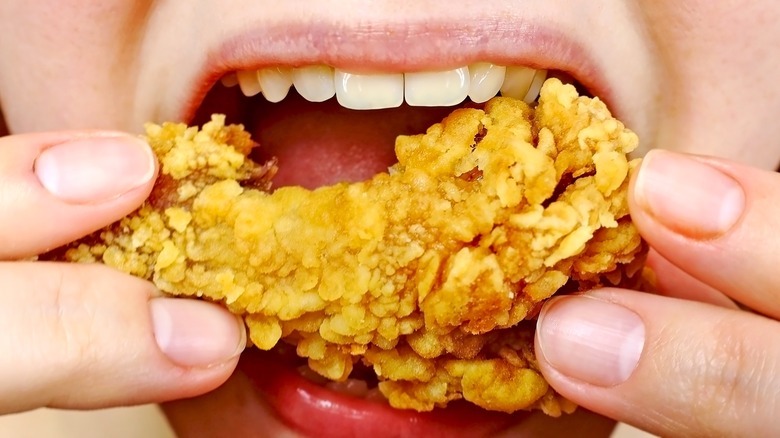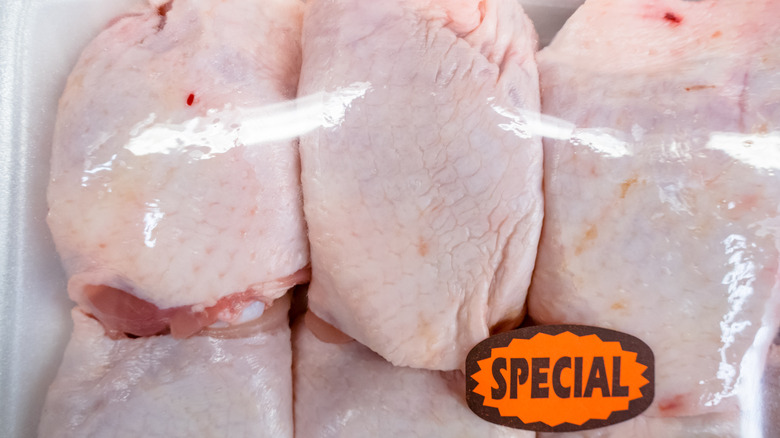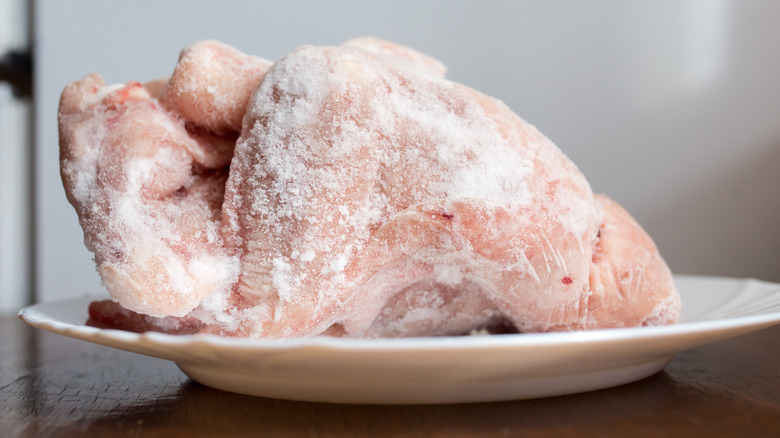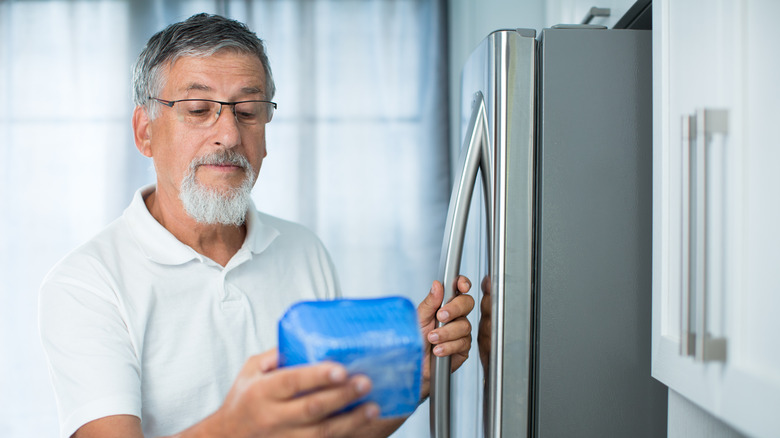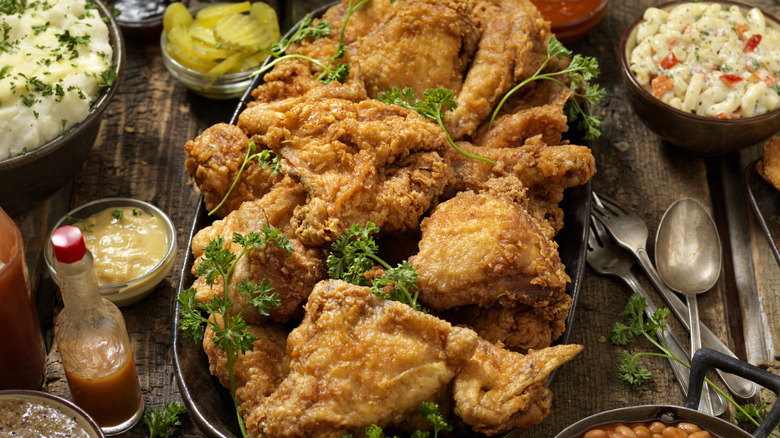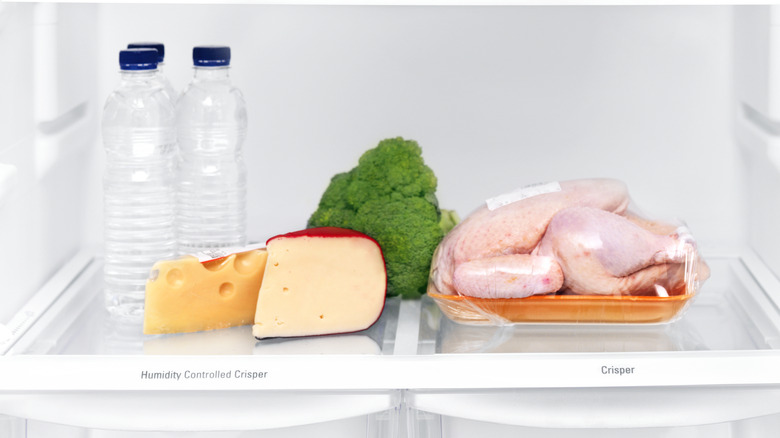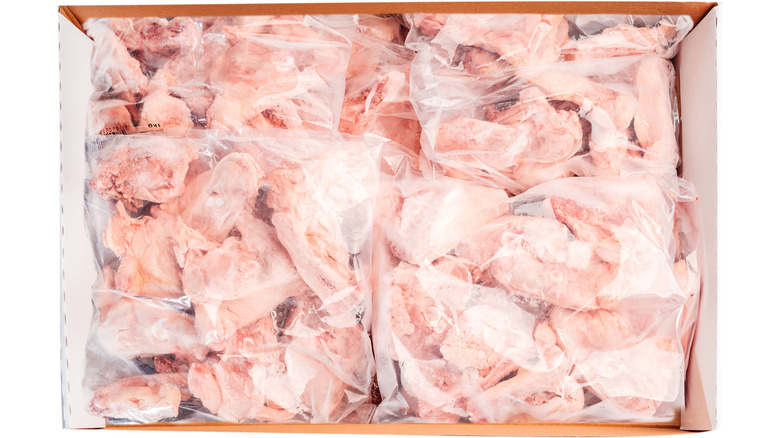Telltale Signs Your Chicken Has Gone Bad
Chicken is a cherished food staple that works for both quick weeknight dinners and elegant options when a wow factor is necessary. It's easily the most popular source of animal protein in American homes; in fact, the average consumer eats around 100 pounds a year (via Statista). You probably have some in your refrigerator right now. But exactly how long does it last there — and what indicates that it's time to toss?
When it comes to food safety, there's little room for error. Learning how to identify the signs of spoiled raw or cooked chicken can save you from an unpleasant eating experience as well as more serious repercussions like food poisoning.
Breathe easy with some simple tips to help you make the right call when you're dealing with potentially iffy chicken. We've got you covered with the telltale signs including color, smell, and texture so you can confidently serve succulent, safe chicken every time.
Check the color
Appearance is one of the easiest ways to decide if chicken is worth keeping. Fresh raw poultry has a pink or whitish-pink tint. A bit of darkening is possible once the flesh is exposed to open air, but it should not be extreme. Green or gray flesh is a clear sign that spoilage has taken hold. Discard immediately if any of these appearance-based indicators are present.
Cooked chicken can range in hue from white to light brown, but check for mold growth, especially if the chicken has been stored for over three days in the refrigerator. Unnatural colors or spots on the flesh are markers of bacterial growth that can cause salmonella or food poisoning.
Also, be on the lookout for cooked chicken that appears mushy or overly wet. The eyes never lie — it's best to throw away a stored dish that appears to be going downhill. Chicken stored in the refrigerator that still appears firm, white, and tender is safe to enjoy.
Let the smell test be your guide
A strong, unpleasant odor is a dead giveaway that your chicken is past its prime. But you may be wondering how exactly to discern between the standard (not-so-great) scent of raw chicken and the stuff that could potentially harm you. A faint, fleshy odor is normal for storebought bird. Spoiled chicken may smell like sulfur, dirty socks, or ammonia. Not exactly appetizing, right?
If the smell is potent, it's probably time to discard. The same goes for cooked chicken — a foul smell is the ultimate giveaway that it's simply not edible. A study in Poultry Science has shown that bacteria putting off these repellent aromas clearly mark chicken that's unsuitable to eat.
A simple whiff can give you a wealth of information and help you avoid making costly mistakes in the kitchen. This intuitive step is an essential part of maintaining food safety, especially when it comes to an ingredient like chicken.
If it's slimy, scrap it
A light, wet film is normal for raw chicken right out of the pack, but if there's a slimy texture after patting it dry or seasoning, you may have a problem on your hands. Being slimy, sticky, or overly glossy suggests that the chicken is unsafe to eat.
Raw chicken should be firm and moist, not tacky or weepy. Learning the difference can help save you and your family from ingesting potentially dangerous food. The texture test can reveal issues with chicken that looks and smells acceptable but could harbor germs.
As for cooked chicken, slime can indicate significant bacterial growth, so it's best to let it go. Extremely soft or slippery chicken leftovers will not only leave a bad taste in your mouth but could also expose you to a host of harmful pathogens. If you're on the fence, choose to be safe over sorry in this situation.
The taste isn't quite right
Be on the lookout for overwhelming or unfamiliar flavors when you take a bite of your favorite leftover chicken dish. By all means, experiment with a range of different recipes and seasonings, but poultry itself with an acidic, metallic, or overly bitter taste is better off in the trash bin.
Also, be wary of a sweet flavor or aroma, as this could be a sign of the proteins in the chicken breaking down (and being past their prime). The safest method in this situation is to analyze the taste before swallowing and possibly ingesting harmful foodborne germs. If the mouthfeel is off (think extremely soft or slimy), spit it out immediately and discard it.
This should be the last stop for gauging whether chicken has gone bad or not, and should only be done if more obvious signs like smell and appearance have passed the test. If the taste is to your liking, you're safe to enjoy.
Improper or damaged packaging in-store
You should examine all food packaging thoroughly, but be especially aware of unsealed or damaged plastic coverings for raw chicken. If you notice any tears, perforations, or openings, steer clear of purchase and alert the store. Even if the chicken is within its "sell by" or "best used by" dates, improper packaging signals increased exposure to pathogens.
In-store issues aren't limited to missing seals and tears — check for puffy or bloated packaging as well. This increased air can indicate bacterial growth that makes the meat unsafe, and while this is not always grounds for disqualifying chicken, it's best to err on the side of safety.
If you feel the frozen chicken you've found at your local grocer may have been thawed and refrozen, avoid it at all costs. This process raises the chance of germ growth while also degrading the flavor and texture. Signs of this may include freezer burn, ice crystals, or discoloration.
It's entered the danger zone
Letting your chicken thaw to room temperature on the counter is a risky game that should be eliminated from your kitchen habits. Unstable temperatures create the ideal environment for harmful germs to flourish.
The USDA warns against this practice, recommending that cold foods be kept cold (under 40 degrees Fahrenheit) until it's time to cook. The danger zone is any temperature between 40 and 140 degrees, especially if the meat remains at these temperatures for more than two hours. If you need to thaw, do it safely by keeping it overnight in the refrigerator. Place the chicken in a plastic bag or container and allow it to fully defrost on a low shelf (to avoid interaction with other food items).
Another safe method is the cold water bath. Simply submerge sealed or bagged chicken into cold water, making sure it's completely covered, and change the water every 20-30 minutes. Cook the chicken immediately after thawing to minimize risk.
The expiration date has come and gone
Seek out the "sell by" or "best if used by" dates for peace of mind when selecting your poultry — and stick to them. Ingesting chicken with an expiration date that has passed could possibly expose you to bacteria like campylobacter or salmonella.
While the sell-by date is more directed at retailers, letting them know a safe timeframe in which to either move or discard the product, the use-by marker is for consumers to be aware of the last possible day for safe consumption. This also supplies to products containing raw or cooked chicken, like salad kits, fresh soups, and snack boxes. There is an option to freeze by the use-buy date as well; this is a secure way to extend the life of your chicken until you're ready to cook it.
While chicken can be safe for consumption for a day or so after the expiration date, it's best to adhere to the guidelines for a worry-free eating experience.
It's been sitting out for longer than two hours
Ever let chicken casserole sit out at a potluck or allowed rotisserie chicken to hang out on the counter all day? It's a bad idea. Don't make the potentially dangerous mistake of leaving cooked chicken out more than two hours, or even worse, overnight. The chicken in question may not look or smell unpleasant, but there could be danger lurking all the same.
Although reheating can take care of surface bacteria, there are pathogens powerful enough to withstand the cooking process. If you want to avoid uncomfortable after-effects like food poisoning, refrigerate leftover cooked chicken before the two-hour mark, shortening it to one hour if the ambient temperature is over 90 degrees Fahrenheit. Leaving cooked chicken out for extended periods also increases the likelihood of toxins from the environment, such as staph from unwashed hands, contaminating it.
If you're planning on a buffet-style service or outdoor meal, keep this important guideline in mind. Keep the chicken at a steady temperature over 140 degrees Fahrenheit or refrigerate within the crucial 2-hour period.
At-home storage missed the mark
Once you've purchased your poultry and carted it home, proper storage is essential. Make sure to refrigerate, freeze, or cook your chicken right away to decrease the chances of bacterial growth. Failure to store it correctly can result in a range of issues that make meat inedible.
Firstly, refrigerate the chicken as soon as you're home. Maintaining a safe, cold temperature is crucial for keeping bacteria at bay. You may need to divide large amounts of poultry to expedite the cooling process, especially if it's a long ride between the grocery store and your final destination. If you're removing the meat from its original packaging, place it into airtight containers for a long, safe shelf life.
Store uncooked chicken on a low (or bottom) shelf to make sure it doesn't drip onto other foods, placing it in the coldest possible spot. Toss any uncooked chicken remaining in the refrigerator after 1-2 days, extending the time to 3-4 days for cooked.
Freezer faux pas
The USDA states that properly frozen chicken can last indefinitely, but be mindful of power outages, temperature shifts, or any changes that could interfere with this highly efficient preservation method. Proper freezing methods extend the safety, flavor, and texture of this popular grocery item, but a misstep can spell a potential health hazard.
"When you're starting to prepare to freeze your poultry, make sure that you're working with clean hands, utensils, equipment, and prep area," says NC State Extension food specialist Candice Christian. "What you want to do is create multiple layers — wrap it in plastic wrap or freezer paper first, followed by foil and an appropriate freezing container or bag."
Look for signs of improper freezer storage like freezer burn or large ice crystals — while they won't harm you, they point to a decrease in overall quality. Defrost the chicken in the refrigerator 24 hours before cooking for a fuss-free transition and enjoy.
